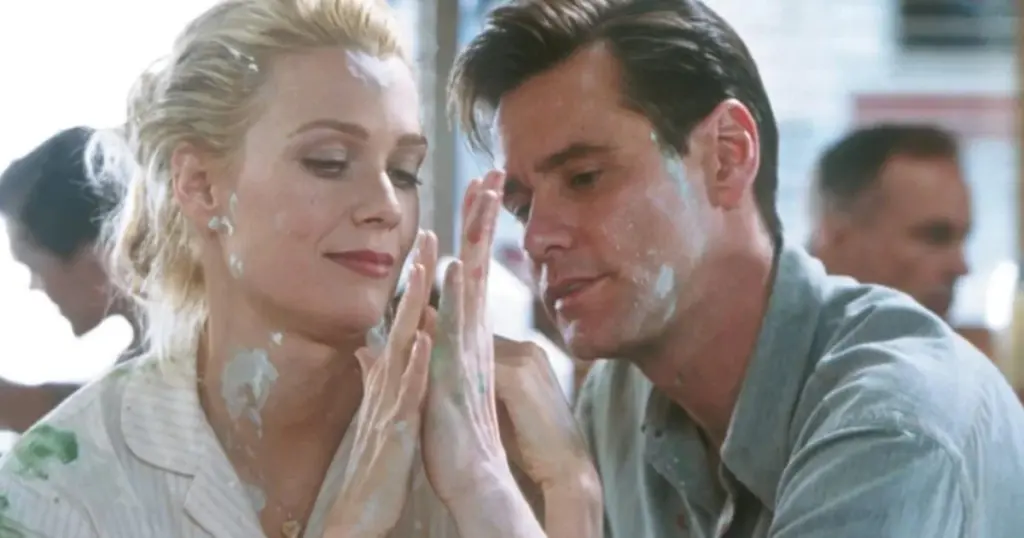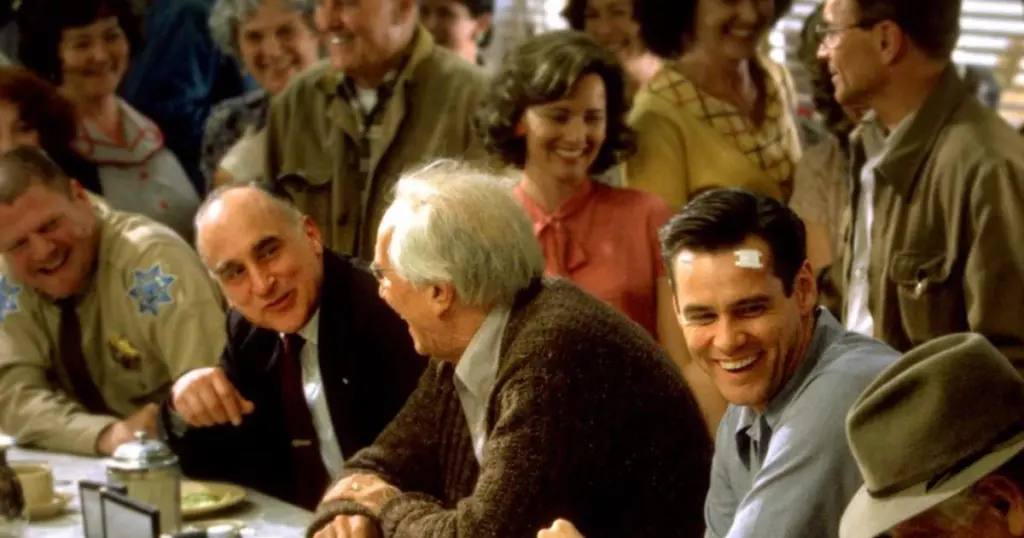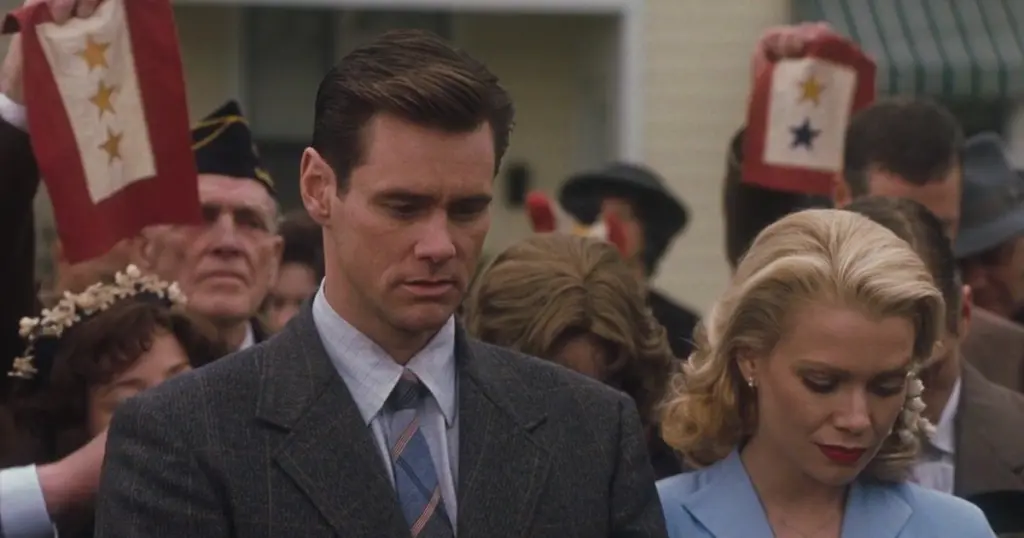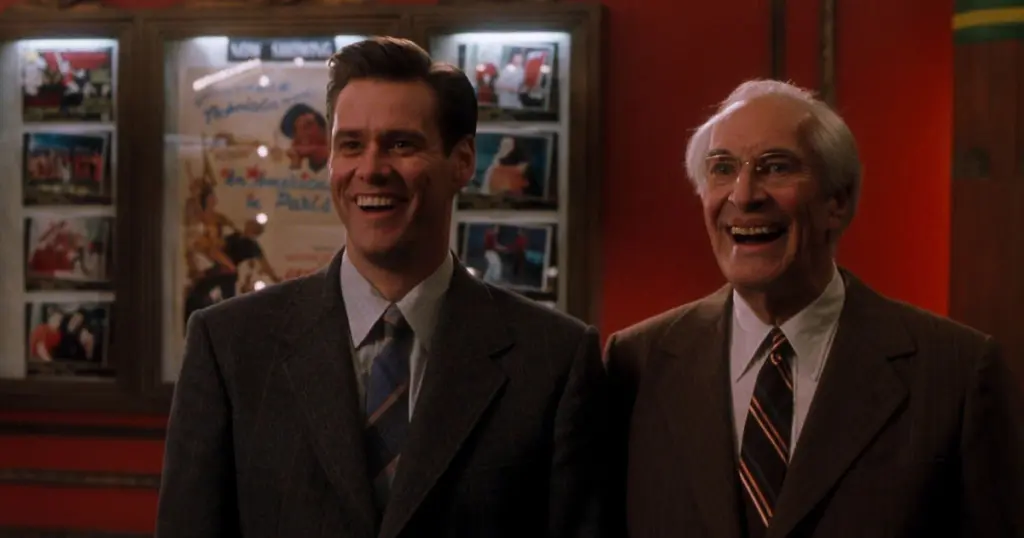
The year was 2001, in the wake of the terrorist attacks of September 11, many studios struggled to find the proper way to market and release their films while still being sensitive to what had just happened. Many films were moved off their original release dates to give the studios, and audiences, more time to figure out the proper way forward. One film, however, was deemed a slam dunk: a feel good story about a man who loses his memory and is taken in by the people of a small town when they assume him to be a long lost son and World War II hero, set against the backdrop of the Hollywood Communist witch hunt of the 1950’s from a respected Oscar nominated filmmaker and starring a lead actor who was in the midst of a dramatic left turn in his career with back to back Golden Globe wins for Best Actor. Of course, when the film was released, talks of Oscar nominations were quickly replaced with questions of how it could all go so wrong. It’s time to kick back with a bucket of movie theater popcorn as we answer the question: WTF Happened to The Majestic?!
Frank Darabont was just your average person, born in a refugee camp in France in 1959 to parents who fled Hungary during the 1956 Hungarian Revolution before his entire family, all five brothers, four sisters and three cousins immigrated to Los Angeles after a short stint in Chicago. As a teen he would attend the famed Hollywood High School where he would meet and form a lifelong friendship with writer Michael Sloane, a friendship that will come in to play momentarily.
After high school, Darabont skipped out on college, electing to follow his love of movies to a job at the renowned Grauman’s Chinese Theater where he worked as a concession employee and usher, no doubt a place where he developed a deep admiration for old school movie theaters.
Darabont would kick off his movie career as a production assistant on films such as Hell Night (1981) and The Seduction (1982)before writing and directing the short film The Woman in the Room (1983) which was an adaptation of a short story of the same name by Stephen King. King granted permission to Darabont as part of his Dollar Baby Initiative which grants permission to students and aspiring filmmakers to adapt one of his short stories for just $1. Darabont simply wrote King a query letter asking for permission, and King granted it. The endeavor proved a successful one as the short film was a semi-finalist at that years Academy Awards. Although Darabont says he was unhappy with how that filmed turned out, King wasn’t, and he gave Darabont the rights to another one of his short stories: Rita Hayworth and Shawshank Redemption.
After making his feature directorial debut with the TV movie Buried Alive, Darabont would go on to write for The Young Indiana Jones Chroniclesbefore finally finding time to adapt the now shortened titled The Shawshank Redemption. Despite the film being hailed by many as the greatest movie ever made, at the time of its release it was actually a pretty notorious bomb, pulling in just $16 million off a $25 million budget. Of course critics raved about the film and those raves would help the film ride a wave of success to the Academy Awards where it was nominated for six oscars including Best Adapted Screenplay for Darabont.
Darabont would follow that up with another prison based Stephen King adaptation: The Green Mile. It would be during the production of this film that Darabont’s old friend Michael Sloane presented him with an original script he had written titled: The Bijou. Darabont loved the script, comparing it to the films of the great Frank Capra. He agreed to get to work on the project as soon as he finished with The Green Mile.Of course in the time between the projects, Darabont’s stock would rise yet again as The Green Milewent on to be a box office smash with nearly $270 million worldwide with Darabont adding another two Academy Award nominations to his name when the film was nominated for Best Picture and Best Adapted Screenplay.
True to his word, Darabont got immediately to work on The Bijou although the film would ultimately change its name to The Majestic after it was believed that Bijou was a little too obscure of a name with some saying they believed the reason Darabont’s Shawshank Redemption didn’t perform better at the box office was due to the name also being a bit obscure. I guess the name Majestic is just more… majestic!
With a script and title in place, it came time to cast. Darabont first offered the lead role of Peter Appleton to his Green Mile star Tom Hanks who turned it down, they then offered the role to Matt Damon who turned the role down so he could star in The Bourne Identity,which in hindsight, was 100% the right decision! Of course Damon would still remain a part of the project as he provides the voice of Luke Trimble towards the end of the film when the farewell letter is read. And that farewell letter wasn’t just a piece of great fiction writing, it is actually pieces of a real letter sent in 1861 from a Major Sullivan Ballou to his wife, a week before he was killed at the First Battle of Bull Run by Confederate Forces during the Civil War.
Jim Carrey was just a simple Canadian boy who grew up to be a stand up comedian who would gain national attention on the hit sketch comedy series In Living Color before making the successful transition to the big screen in 1994 with three films that are now considered comedy classics: Ace Ventura: Pet Detective, The Mask and Dumb and Dumber. For many, Jim Carrey was the funniest man in America, something that apparently Tommy lee Jones was no fan of when he flat out told Carrey that he didn’t like him while shooting Batman Forever. The success of Jim Carrey as a leading man would lead to him becoming the first actor to ever receive a $20 million payday when he took on the lead role in the under-performing and under-rated Ben Stiller directed The Cable Guy. But even though that film didn’t light up the box office, what it did do was show that Carrey could be effective taking on darker and more dramatic roles. This would lead to him being cast in the more drama centric film Simon Birch as well as taking on the lead role in the Peter Weir directed The Truman Show. Carrey earned rave reviews for his comedic, yet subdued and actually quite heart breaking performance as Truman Burbank, a man who doesn’t know his entire life is a farce. Carrey would go on to win the Golden Globe for Best Actor, yet in one of the more shocking omissions in Oscar history, was not one of the five nominated for Best Actor at that years Academy Awards.
The following year, Carrey would give another performance that saw critics again singing his praises when he took on the challenging role of Andy Kaufman in the Milos Foreman directed Man on the Moon. Carrey would yet again win the Golden Globe for Best Actor, making him a rare back to back winner, yet again, in another one of the biggest snubs in Oscar History, Carrey did not receive an Oscar Nomination for his spot on portrayal of the comedy legend.
It was at this time, when Carrey was taking on more dramatic material, almost as a way to show critics he was more than the guy who made a name for himself by talking out of his butt, that he was approached with the script for The Majestic (although it was still called The Bijou at the time) and would sign on immediately, after producers agreed to give him his full $20 million quote.
With a $72 million budget in place (which includes that $20 million paid to Carrey) The Majestic began rolling cameras on March 5, 2001 in Los Angeles before moving up north to the more peaceful Ferndale, California where the bulk of filming took place, ultimately wrapping production on June 29, 2001.
The film would pay homage to those who were actually a part of Senator Joseph McCarthy’s Communist Witch Hunt: the town of Lawson is named after screenwriter John Howard Lawson who was one of many blacklisted screenwriters. When speaking to the Mayor, the name Cole is used to reference another blacklisted screenwriter Lester Cole and the name Luke Trimble was used as a nod to Dalton Trumbo, yet another blacklisted screenwriter who would gain more fame when Bryan Cranston would be Oscar Nominated for portraying him in the film Trumbo. Even the name of the lead character, Peter Appleton, is a nod to Joseph McCarthy’s hometown of Appleton, Wisconsin.

In addition to its impressive cast which included such talented people as Martin Landau, Bob Balaban, Ron Rifkin, Hal Holbrook, Catherine Dent, Brent Briscoe, Jeffrey DeMunn and Laurie Holden, the film would feature cameo appearances (in voice only) from Hollywood heavyweights Garry Marshall, Paul Mazursky, Sydney Pollack, Rob Reiner and his father Carl Reiner playing the studio executives that open and close the film, with Darabont choosing to not show these titans on screen as the camera just focuses on Jim Carrey’s face while receiving the studio notes. Obviously that was a fun scene for Darabont to film as he is no stranger to getting asinine studio notes and having to smile and nod politely in the room.
But it wasn’t just those relationships Darabont drew on to help make the movie. For the film within a film: Sand Pirates of the Sahara, Darabont would call up his good friend Chuck Russell whom he had previously worked with on A Nightmare on Elm Street 3: Dream Warriors with Darabont one of four writers credited for the script and Russell directing. At the time Russell was taking on the Dwayne Johnson led film The Scorpion King and would let Darabont use props from his film to add a little extra production value to Sand Pirates without bumping up the production budget. Darabont would also draw upon his friendship with Steven Spielberg when Spielberg lent Darabont the golden idol from Raiders of the Lost Ark for use in the Peter Appleton scripted film.
Once shooting was completed, it came time to edit and test the film. Due to Darabont having had success with longer films, Shawshankran two hours and twenty two minutes while the far more lucrative Green Mile ran a full three hours and nine minutes. So given those factors, the studio didn’t really interfere with Darabont and his desire to make The Majestica longer movie. That isn’t to say they didn’t test out two different versions of the film, because they did! The studio would test a shorter version of the film and the longer version, the longer cut tested way higher than the shorter cut and thus The Majestic would lock picture at two hours and thirty three minutes.

With a prime release date of December 21, 2001, The Majestic was the talk of the town with many comparing it to the Frank Capra/ Jimmy Stewart classic Mr. Smith Goes to Washington. It was primed and ready to be a massive break out with many predicting it would be the big winner come Oscar night considering it was a movie from a filmmaker with a track record of critical success and featured a lead actor that many assumed couldn’t be over-looked a third time for a Best Actor Oscar nomination.
And then the film was released! The first reviews began pouring in calling the film overlong with a forced sentimentality and that it aimed to be an inspiring tale but failed due to over-sappiness and a slow pace. There were some good reviews mixed in however, many critics did enjoy the take down of McCarthyism and called the story “beautiful” with famed thumbed one Roger Ebert even saying the film was a proud patriotic hymn to America. Jim Carrey’s performance would split critics, some claimed he was badly miscast in this purely dramatic role and blamed his performance on chasing an Oscar, while others (including Roger Ebert) hailed it as Carrey’s best performance to date even comparing him to the everyman qualities exhibited by a Jimmy Stewart.
Yet critics weren’t the only ones who turned their noses at this ode to the magic of the movie theater: audiences just didn’t show up. The film would open to just $4.9 million and an eighth place finish. Many people attributed the poor opening to not just the reviews, but also opening the film in such a crowded market. The Majestic opened on the exact same day as The Lord of the Rings: The Fellowship of the Rings which consumed audiences attention that weekend with $47.2 million, but it also lost out to the opening weekend of Jimmy Neutron: Boy Geniusand the Method Man/ Redman comedy How Highas well as the continued successes of Ocean’s Eleven, Vanilla Sky, Harry Potter and the Sorcerer’s Stoneand even Not Another Teen Movie. I guess to put a positive spin on it we should point out that it wasn’t actually the worst performing new release of that week: the Tim Allen starring Joe Somebody actually finished with about $1.5 million less than The Majestic… so that’s something at least!

There was a lot of Monday morning quarterbacking going on for this release as no one really expected it to bomb as bad as it had. Sure the reviews and crowded marketplace definitely played a factor, but many thought there were others reasons the film tanked so badly. Many pointed to the fact that the film didn’t really have a targeted audience, noting that the typical Jim Carrey fan expects to see him at least being somewhat funny, but the trailers for the film had no comedy in them whatsoever. Many critics would point to the terrorist attacks of September 11th and say that even though the film had a backbone that represented the faith and freedoms of America, as well as being a loving ode to the soldiers who had fought and died in previous wars for those freedoms, audiences just weren’t ready for that yet.
And that American spirit actually hurt the films box office over seas. Released in the UK on May 24, 2002, the film would fail to crack the top ten with UK audiences saying the ending of the film, with its powerful courtroom scene, had no real emotional impact for them as it had no relevance to their world or history. The film would fail to make even $10 million overseas and would ultimately end its worldwide run with just $37.3 million, nowhere near its $72 million budget.
In the aftermath of the film, Jim Carrey and costar Laurie Holden would begin a romantic relationship that eventually ended, but the two must have remained friends as the pair would reunite in 2014 for Dumb and Dumber To.
For his part, Jim Carrey hasn’t really spoken about The Majestic often, only saying briefly that it his least favorite role he has ever played and that he regrets accepting it while Frank Darabont has painted a different tune saying he is extremely proud of the movie and that it achieved exactly what he set out to make. He said that he once read in a magazine article that was praising his work on Shawshank that he needed to apologize for making The Majestic to which he audibly reacted “Really? I need to apologize? Kiss my ass!”
Darabont would return to the world of Stephen King adaptations by making The Mist in 2007 followed by developing The Walking Dead television series which he would be fired from after just a season and a half (of course that firing led to a $200 million settlement, so don’t feel too bad for him)!) While Jim Carrey would continue making critical and commercially successful films including another Oscar Snubbed performance in Eternal Sunshine of the Spotless Mind.
But for as big of a bomb as The Majestic is always touted as being, it does seem to have caught on with audiences recently with the film featuring a solid four and a half star rating on Amazon based on nearly 2000 user reviews. It appears that without all that expectation and hype, The Majesticmay have finally found its audience.
And That’s WTF Happened to The Majestic!
Originally published at https://www.joblo.com/wtf-happened-to-the-majestic/